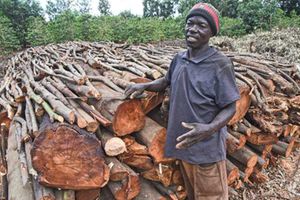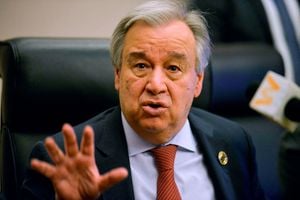
Artist’s impression of Nairobi to Mau Summit toll road once it is completed.
Not even a meeting between President William Ruto and his French counterpart Emmanuel Macron at Elysee Palace in Paris in January last year could save the French contractors from losing the contract for upgrading of the Nairobi-Nakuru-Mau Summit Highway.
On March 18, 2024, the Kenya Kwanza administration pulled the plug on the Public Private Partnership (PPP) contract to upgrade the $1.3 billion (Sh170.9 billion) road from Nairobi to Mau Summit, putting Kenya at risk of paying hefty termination fees and getting into a diplomatic spat with France.
The National Treasury, in one of its reports, has put the termination costs of the project at Sh100 million ($761,000), but previous cases such as the termination of the Green Field Terminal at the Jomo Kenyatta International Airport (JKIA), shows that the penalties in such big projects typically run into billions of shillings. Attempts to get the views of Rift Valley Highway Limited (RVHL), the consortium of three French firms that won the tender, were not successful.
The cancellation of what was going to be one of the largest French infrastructure projects in Africa is also likely to inflame relations between Kenya and France. The French had made it clear that completion of the project was a major diplomatic plank between Paris and Nairobi.
The project was conceptualised and launched in 2016 by the administration of President Uhuru Kenyatta to decongest the Northern Corridor and reduce travel time as Kenya sought to beat Tanzania’s Central Corridor.
For some unknown reasons, alarm bells went off in Paris as soon as Dr Ruto was declared Kenya’s fifth President. The European nation immediately started lobbying for the new administration to allow the French contractors to break ground on the project that had the financial backing of, among others, the African Development Bank and the World Bank.
The presence of the French envoy, Chrysoula Zacharopoulou, at Dr Ruto’s inauguration in September 2022, and later her closed door meeting with the new head of state at State House, Nairobi, signalled a change of fortunes for the French contractors for the Mau Summit road.
The consortium of Vinci Highways, Meridian Infrastructure Africa Fund, and Vinci Concessions had just crossed yet another legal hurdle after the High Court in March 2022 dismissed a petition to nullify the contract by a consortium that had lost the tender.
Earlier, the Public Private Partnerships Petitions Committee had also dismissed the same petition by a consortium of Egis Projects S.A (France), Mota-Engil-Engenharia E Construcao Africa, S A (Portugal), Africa Infrastructure Investment Managers Seed Partnership (South Africa), and Orascom Construction Ltd (Egypt).
But now, just when the contractors were ready to move to the ground, the new government was having a change of heart.
A day after the State House meeting, Ms Zacharopoulou oozed optimism. She told journalists that with the end of the elections, the talks between the contracting parties would resume. She made it clear that it was up to Dr Ruto to decide when works on the Northern Corridor road would begin.
“We have to resume talks, obviously, but it would be something important and would be nice for the new administration to speak with the companies,” said Zacharopoulou.
But this did not stop the government from freezing the construction of the project reportedly to allow for the renegotiation of the contract.
The contractor was going to recoup its investment by charging toll fees under the 30-year concession.
“We are still in negotiation. It became a bit hard for us to afford going by the current dynamics, so we requested them to review their presentation to be able to see whether we can make them affordable,” said the Roads Principal Secretary Joseph Mbugua.
The problem, according to a statement from the Kenya National Highways Authority (KeNHA), the procuring agency, was Availability Based Service Payment model.
With this model, the government would make monthly payments to the contractors based on performance to specified levels and the availability of the contracted infrastructure.
In other words, if the contractor does not get the specified traffic, the government would compensate for the deficit. This was “to guarantee investors returns which now have reached unaffordable levels,” said KeNHA in the statement.
KeNHA said that although the project was a PPP, the government was allocated the traffic risk due to lack of historical data on the performance or acceptability of toll roads in Kenya. There was also no reliable traffic data that could be used for toll revenue projections.
Tolling of roads was one way for a cash-strapped government that nonetheless still had a huge infrastructure gap to have its cake and eat it. Through PPP, the government which had run out of headroom for borrowing could still build roads without incurring additional loans.
The Mau Summit Road, a critical artery of the Northern Corridor linking Nairobi to Western Kenya and the neighbouring Uganda, Rwanda and the Democratic Republic of Congo, was among the first roads identified for tolling.
However, affordability proved to be a thorny issue.
“When we looked at the road (the Mau Summit Road), it was actually going to be the biggest infrastructure transaction in Africa. Unfortunately, that transaction was going to cost the user $6 (Sh800) to drive 175 kilometres in a small car and close to $50 (Sh6,641) for one truck to go 175km,” said Christopher Kirigua, the exiting director-general for the Public Private Partnerships (PPP) at the National Treasury.
There were also those who were opposed to the tolling of a regional road without providing an alternative route, like is the case with the Nairobi Expressway which runs from Westlands to Mlolongo in Machackos County.
“KeNHA requested a restructuring of the contract and shift of the traffic risk to RVHL but the proposal was considered unbankable thus creating a stalemate on how to progress with the project. This resulted in KeNHA issuing a notice for terminating the PPP contract on 18th March, 2024 after securing the requisite approvals and the termination is expected to occur on 18th September, 2024,” said KeNHA.
This means that the tendering for the project will start afresh. The Ruto government has been enticing the Chinese, who already operate the Nairobi Expressway, to also take up the building and operation of the Mau Summit road.
The Mau Summit Road was not only going to be one of the biggest infrastructure projects in Africa, but it was also going to mark a major geopolitical score by France as the European nation sought to gain a foothold in Anglophone Africa. Mega infrastructure projects in Kenya have been dominated by China.
Last week, the government confirmed that it had terminated the $1.3 billion project that would see the 175 kilometres Nairobi-Nakuru-Mau Summit Road upgraded into a dual carriageway by a consortium of three French contractors.
The cancellation brought tremors to the Kenya-France relations which had in recent times, particularly under the administration of retired President Uhuru Kenyatta, been anchored on the fruition of the project.
Relations between Kenya and France blossomed under the Uhuru Kenyatta regime. As the French gradually shed the vestiges of la Françafrique – a murky arrangement that bound France’s business and political interests with those of the people who ran its former colonies, mostly in West Africa – they have set their sights on more lucrative English-speaking countries. Kenya, a gateway to East Africa and the region’s most progressive economy, was a perfect target for the French.
From the return of direct Air France flight after 18-year hiatus and the assembly of Peugeot cars; from increased imports of Hennessey and Champagne to the entry of Carrefour and Rubis Energie, the French descended in Kenya in droves during the Kenyatta period.
And it appeared as though it was Kenyatta himself who guided the French entry into East Africa.
Kenyatta family’s Brookside, a dairy processing company, was among the first active participants in the resurgent French activities in Kenya.
In 2014, the Kenyatta family ceded part of its stake in Brookside to Danone, a French food group.
Three years later, Brookside relinquished its entire stake in a Tanzanian subsidiary to Danone.
But it appears things are changing under the new administration.









